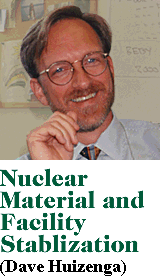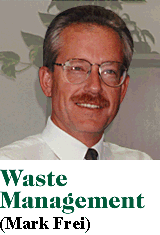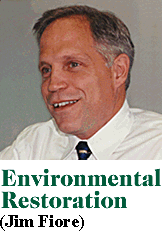

 |
EM-60's Dave Huizenga sees his organization as "the new kid on the block" in terms of collaboration with OST. While Waste Management and Environmental Restoration have been the focus of science and technology activities for years, it's only in the last year or so that OST has been able to devote much of its budget to Nuclear Material and Facility Stabilization activities. |
| Huizenga pointed to needs in three areas:
plutonium stabilization, uranium stabilization, and spent
fuel. In all cases, his program is pursuing not just new
technologies (better ways of doing things) but also new
approaches (better things to do). For example, in the
case of both foreign and domestic research reactor fuel,
the intention is to cease reprocessing operations and
thereby phase out the use of the Savannah River Site's F and
H canyons. The wiser alternative to reprocessing, when
feasible, is to dispose of the fuel directly to on-site
dry storage, as is done with spent fuel from power
reactors, pending planned final disposition at Yucca
Mountain. This direct disposal option is likeliest at
Idaho, where the fuel cladding is mostly stainless steel.
For the mostly aluminum-clad Savannah River fuel, the
approach is to "melt and dilute" the (mostly)
highly enriched uranium fuel elements with depleted
uranium, to prevent criticality events when the resulting
canisters are placed in dry storage. EM-60 hopes, over
the next year or two, to enlist OST support in overcoming
technical or regulatory (e.g., Nuclear Regulatory
Commision licensing) obstacles that may arise in pursuing
this approach. With respect to the plutonium residues at Rocky Flats, another major EM-60 responsibility, Huizenga says his organization is pursuing a "dual-path approach." First, send as much as possible to Waste Isolation Pilot Plant (direct disposal). This path became a reality with the availability and NRC licensing of the Pipe Overpack Transportation Packaging developed at Sandia National Laboratories with OST support. Where direct disposal is not an option, as with many plutonium residues, EM-60 is collaborating with the Plutonium Focus Area on the Cold Ceramification Process to solidify residual ash, and with OST regulatory experts to ensure that the resulting solid complies with the WIPP Waste Acceptance Criteria. EM-60's responsibilities entail needs for science as well as technology. Huizenga says, "We have two thousand tons of fuel at Hanford to move from the K Basins to the Canister Storage Building. Can that fuel go to the repository, or does it need to be repackaged or treated to avoid pyrolysis? There's a science aspect to this issue." Moving radioactive materials is a large part of the second part of EM-60's name: facility stabilization, or deactivation. Deactivation mostly means removing all nonfixed sources of contamination; once a building is thus deactivated, it can be handed over to Jim Fiore for decontamination. Huizenga says his organization has "done a lot with OST on nuclear material stabilization, but we haven't focused as much on facility deactivation." And although progress in this area is surely being made (the PUREX facility at Hanford was formally deactivated in FY 1997, and the Hanford B Plant canyon deactivation will be completed later this year), what's needed to speed deactivations is remote technologies for highly contaminated spaces, as well as size reduction of gloveboxes." OST's Robotics Technology Development Program and an FY 1998 ASTD project at Rocky Flats, Enhanced In Situ Decontamination and Size Reduction of Gloveboxes, are aimed at precisely such challenges. Huizenga says that "It's been a pleasure to work with Gerald, and we're making progress. But as the `new kid on the block,' we're trying to find dollars Gerald has already mostly committed to others' projects. At the moment, given their budget constraints, OST is being as helpful as it can. Gerald Boyd has made many attempts to get to know our program and to see where he can help." "We have," Huizenga says, "a whole new management team in EM, and we're working well together." Perhaps it won't be long before all of them—Frei, Fiore, Huizenga, Boyd—can remove the "[Acting]" from their titles and be as real as the collaboration already evident among them. |
|
| Click on each of the (acting) deputy assistant secretaries below to see how OST rates with its customers. |
 |
 |
|